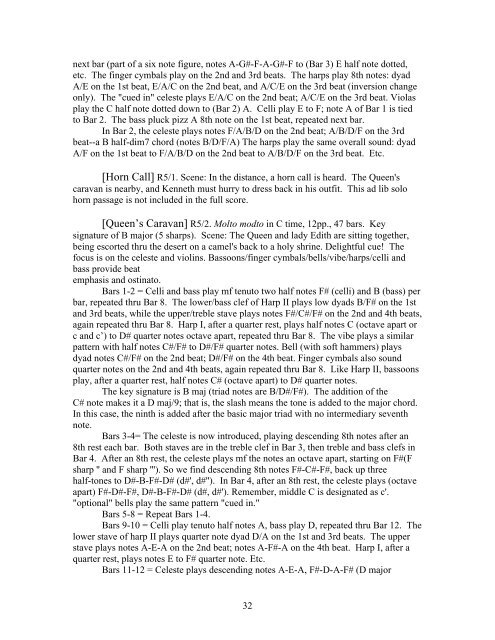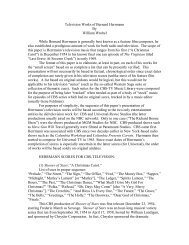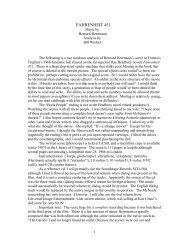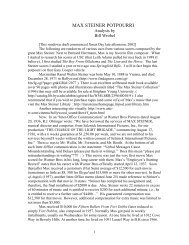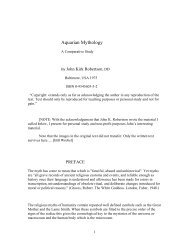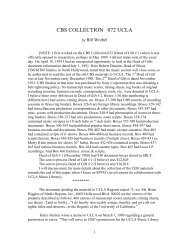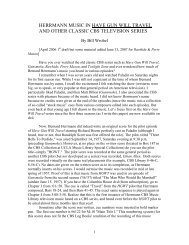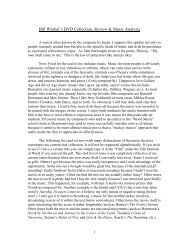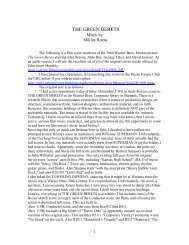next bar (part of a six note figure, notes A-G#-F-A-G#-F to (Bar 3) E half note dotted,etc. The finger cymbals play on the 2nd and 3rd be<strong>at</strong>s. The harps play 8th notes: dyadA/E on the 1st be<strong>at</strong>, E/A/C on the 2nd be<strong>at</strong>, and A/C/E on the 3rd be<strong>at</strong> (inversion changeonly). The "cued in" celeste plays E/A/C on the 2nd be<strong>at</strong>; A/C/E on the 3rd be<strong>at</strong>. Violasplay the C half note dotted down to (Bar 2) A. Celli play E to F; note A of Bar 1 is tiedto Bar 2. The bass pluck pizz A 8th note on the 1st be<strong>at</strong>, repe<strong>at</strong>ed next bar.In Bar 2, the celeste plays notes F/A/B/D on the 2nd be<strong>at</strong>; A/B/D/F on the 3rdbe<strong>at</strong>--a B half-dim7 chord (notes B/D/F/A) The harps play the s<strong>am</strong>e overall sound: dyadA/F on the 1st be<strong>at</strong> to F/A/B/D on the 2nd be<strong>at</strong> to A/B/D/F on the 3rd be<strong>at</strong>. Etc.[Horn Call] R5/1. Scene: In the distance, a horn call is heard. The Queen'scaravan is nearby, and Kenneth must hurry to dress back in his outfit. This ad lib solohorn passage is not included in the full score.[Queen’s Caravan] R5/2. Molto modto in C time, 12pp., 47 bars. Keysign<strong>at</strong>ure of B major (5 sharps). Scene: The Queen and lady Edith are sitting together,being escorted thru the desert on a c<strong>am</strong>el's back to a holy shrine. Delightful cue! Thefocus is on the celeste and violins. Bassoons/finger cymbals/bells/vibe/harps/celli andbass provide be<strong>at</strong>emphasis and ostin<strong>at</strong>o.Bars 1-2 = Celli and bass play mf tenuto two half notes F# (celli) and B (bass) perbar, repe<strong>at</strong>ed thru Bar 8. The lower/bass clef of Harp II plays low dyads B/F# on the 1stand 3rd be<strong>at</strong>s, while the upper/treble stave plays notes F#/C#/F# on the 2nd and 4th be<strong>at</strong>s,again repe<strong>at</strong>ed thru Bar 8. Harp I, after a quarter rest, plays half notes C (octave apart orc and c’) to D# quarter notes octave apart, repe<strong>at</strong>ed thru Bar 8. The vibe plays a similarp<strong>at</strong>tern with half notes C#/F# to D#/F# quarter notes. Bell (with soft h<strong>am</strong>mers) playsdyad notes C#/F# on the 2nd be<strong>at</strong>; D#/F# on the 4th be<strong>at</strong>. Finger cymbals also soundquarter notes on the 2nd and 4th be<strong>at</strong>s, again repe<strong>at</strong>ed thru Bar 8. Like Harp II, bassoonsplay, after a quarter rest, half notes C# (octave apart) to D# quarter notes.The key sign<strong>at</strong>ure is B maj (triad notes are B/D#/F#). The addition of theC# note makes it a D maj/9; th<strong>at</strong> is, the slash means the tone is added to the major chord.In this case, the ninth is added after the basic major triad with no intermediary seventhnote.Bars 3-4= The celeste is now introduced, playing descending 8th notes after an8th rest each bar. Both staves are in the treble clef in Bar 3, then treble and bass clefs inBar 4. After an 8th rest, the celeste plays mf the notes an octave apart, starting on F#(Fsharp '' and F sharp '''). So we find descending 8th notes F#-C#-F#, back up threehalf-tones to D#-B-F#-D# (d#', d#''). In Bar 4, after an 8th rest, the celeste plays (octaveapart) F#-D#-F#, D#-B-F#-D# (d#, d#'). Remember, middle C is design<strong>at</strong>ed as c'."optional" bells play the s<strong>am</strong>e p<strong>at</strong>tern "cued in."Bars 5-8 = Repe<strong>at</strong> Bars 1-4.Bars 9-<strong>10</strong> = Celli play tenuto half notes A, bass play D, repe<strong>at</strong>ed thru Bar 12. Thelower stave of harp II plays quarter note dyad D/A on the 1st and 3rd be<strong>at</strong>s. The upperstave plays notes A-E-A on the 2nd be<strong>at</strong>; notes A-F#-A on the 4th be<strong>at</strong>. Harp I, after aquarter rest, plays notes E to F# quarter note. Etc.Bars 11-12 = Celeste plays descending notes A-E-A, F#-D-A-F# (D major32
sound). In Bar 12, notes F#-C#-F#, D#-B-F#-D#.Bars 13-16 = S<strong>am</strong>e p<strong>at</strong>tern in C# maj(C#/E#/G#). Fags on C# to D#notes. Etc.Bars 17-18 = Fags/harps etc repe<strong>at</strong>s Bars 1-2.Bars 19-<strong>20</strong> = Celeste plays F#-C#-F#, D#-B-F#-D#. In Bar <strong>20</strong>, played an octavelower.Bars 21-22 = The violins are finally introduced, playing "molto espr" the melodyline starting with high whole note F# (f# ‘‘‘) [Line 3 F#] tied to 8th note next bar, part ofan eight note figure of 8th notes F#-G#-A#-G#, F#-D#-C#-B. The rest of the instrumentsstill repe<strong>at</strong> Bar 1, except th<strong>at</strong> violas are now introduced playing half notes F (octaveapart) to G quarternotes.Bars 23-24 = Violins melody line continues on the D# whole note tied to 8th nextbar, part of notes D#/E/F#/E, D#/B/G#/F#. The celeste repe<strong>at</strong>s Bars 3-4.Bars 25-26 = Melody line on C# whole note tied to 8th next bar, part of notesC#/D#/E/D#, C#/D#/E/C#. The other instruments repe<strong>at</strong> Bar 21.Bars 27-28 = The melody line continues on whole note B tied to half note nextbar which itself is tied to an 8th, part of a four note figure B/C#/D#/F#.Bars 29-30 = Melody line on whole note F# tied to 8th next bar, part ofF#/G#/A#/G#, F#/D#/C#/B.Bars 31-32 = Melody line on Bb whole note tied to 8th next bar, part of figureBb/Bb/C/Bb, Bb/Bb/C/Bb. Celeste descends 8th notes Eb/Bb/Eb, C/Ab/F#/F to (Bar 32)the s<strong>am</strong>e notes an octave lower. Celli on half notes Bb; bass on Eb. Violas, after aquarter rest, play half notes G (octave apart) to quarter notes Ab/D/F#. Etc.Bars 33-34 = Melody line on Eb whole note tied to next several bars. Harp I, aftera quarter rest, plays half notes F (octave apart) to G quarter note. Harp II plays wholenote dyad Eb/Bb on the 1st and 3rd be<strong>at</strong>s. Etc etc.[Search The Oasis] R5/3. Moder<strong>at</strong>o in C time, 3pp., 11 bars.Scene: The rearguard of evil castalains spot Saladin clinging tightly to a fig tree. In Bar5, they scare Saladin's steed which runs off into the desert. "He<strong>at</strong>hen beast! He washiding cleverly in th<strong>at</strong> thicket." The music plays an Ab sus4 (notes Ab/Db/Eb). Twoharps and piano play a five-note figure of four 16th notes to quarter note (basically aninversion rise). The small gong sounds. Flutes are on whole note Db held ferm<strong>at</strong>a(sustained pause). Clarinets are on Eb/Ab; bass cl on Db; Fags on Db/Ab.Bar 6 = As the rear guard continue the search thru the oasis, a military be<strong>at</strong> plays,commencing with a five stroke ruff mf of the snare drum (four grace notes preceding aquarter note in this case). The timp strikes mp an ostin<strong>at</strong>o (repe<strong>at</strong> figure) of 8th notebe<strong>at</strong>s of A to G#(with 8th rest marks in between). Harps and piano also play be<strong>at</strong> notesA/A/A (three octaves apart) to G#/G#/G#. Strings also play 8th be<strong>at</strong> notes pizzic<strong>at</strong>o,notes A/G#/A/G# per bar. Etc.[Sir Knight] R5/4. Modto in 6/8 time, 4pp., 16 bars. Scene: Vanguard knightKenneth rides up to Lady Edith. The Queen asks wh<strong>at</strong> delays the rear guard. Again, asin the start of R 4 pt 3, we hear the Scot ostin<strong>at</strong>o of an acciacc<strong>at</strong>ura to half note dottedplayed by a clarinet (notes G# to A), a bass cl (notes C# to D) and two bassoons (notes33
- Page 1 and 2: FILM SCORE BLOGS [Blog # 41]Valenti
- Page 3 and 4: I enjoyed watching The Fugitive but
- Page 5 and 6: -“Fugitive Susp.” [I assume Fug
- Page 7 and 8: Then in the Fugitive episode comes
- Page 9 and 10: One purchase I did take advantage (
- Page 11 and 12: session but almost always left behi
- Page 13 and 14: pages to UCSB. The person is Marcus
- Page 15 and 16: triplet value 8ths down to (Bar 2)
- Page 17 and 18: for $2.50 long ago (probably at the
- Page 19 and 20: marriage with Groucho was a joke?
- Page 21 and 22: I discuss this in my final Talking
- Page 23 and 24: “Main Title” Cue #35885 Maestos
- Page 25 and 26: on note B.Bars 13-14 = The ostinato
- Page 27 and 28: whole notes. Timp trill (roll) on G
- Page 29 and 30: Bar 14= The melody line continues w
- Page 31: find 16th notes G#-A-B-C-D-E to 32n
- Page 36 and 37: Bar 24 = Bis on E min again. Bass c
- Page 38 and 39: Cmaj7#9 (C/E/G/B/D#), etc. Clarinet
- Page 40 and 41: amongst them. Very interesting chas
- Page 42 and 43: "Maria's Room" Lento (mesto) in C."
- Page 44 and 45: Principal recording date was July 1
- Page 47 and 48: to quarter notes as Hugo jokes abou
- Page 49: whole notes D/G held fermata. Bass
- Page 52 and 53: music "vira do minho" [unknown auth
- Page 54 and 55: ut with notes D-Eb-E, F, Gb-Ab to (
- Page 56 and 57: Bars 26-32 = The strings and organ
- Page 58 and 59: minor 2nd inversion 8th note chord
- Page 61 and 62: At the end of Bar 4 the baritone tr
- Page 63 and 64: octave F up to small octave C 8ths
- Page 65 and 66: (Bar 3) F/small octave C half notes
- Page 67 and 68: hiding), Rune questions Frail. The
- Page 69 and 70: on G note tied to next few bars. Th
- Page 71 and 72: the beat and the cymbal sounds off
- Page 73 and 74: [“Like what?!”] R6/5. Dramatic
- Page 75 and 76: In Bars 12-19, as she opens her eye
- Page 77 and 78: C#/E/G#/B) followed, after a half n
- Page 79 and 80: starting on F minor by the violins
- Page 81 and 82: twice more. Bar 1 = VC/CB B half no
- Page 83 and 84:
Reel 5 pt 4 "Little Mama" Slow & Te
- Page 85 and 86:
Reel 9 pt 7 "The Camp(original)" Sl
- Page 87 and 88:
G-A-Bb-Line 1 C-D-D# (connected as
- Page 89 and 90:
next bar in the same rest pattern.
- Page 91 and 92:
D-F#-A-D-F#-A-D). The last note D (
- Page 93 and 94:
and violas play "rubato" quarter no
- Page 95 and 96:
case the scene works better without
- Page 97 and 98:
on the first two beats by the flute
- Page 99 and 100:
Reel 9/A "Judith Rejected". Deleted
- Page 101 and 102:
locations after all. These unaligne
- Page 103 and 104:
[Cue #3767] “Discovery of Well”
- Page 105 and 106:
First is John Barry's simple but ef
- Page 107 and 108:
different. But my guess is that the
- Page 109 and 110:
Universal-Revue Studios Television.
- Page 111 and 112:
-All cues # entries (whether 1 page
- Page 113 and 114:
Talking Herrmann: ON DANGEROUS GROU
- Page 115 and 116:
Idea for Markus M.: It would be fas
- Page 117 and 118:
last one is weirdly notated by Herr
- Page 119 and 120:
I did like DePalma's stylist approa
- Page 121 and 122:
___________________________________
- Page 123 and 124:
Thanks for your interesting observa
- Page 125 and 126:
********************************10-
- Page 127 and 128:
Mer,”…certain passages of it, I
- Page 129 and 130:
{Image http://img193.imageshack.us/
- Page 131 and 132:
talkingherrmann mailing list*******
- Page 133 and 134:
While Herrmann was not the King of
- Page 135 and 136:
___________________________________
- Page 137 and 138:
So Herrmann was playing with heavil
- Page 139 and 140:
different takes). I wonder if Bill
- Page 141 and 142:
Talking Herrmann: SUSPENSE THEME (C
- Page 143 and 144:
Talking Herrmann: Mind in the Shado
- Page 145 and 146:
13. Nathan Hale - Cue #8 1:48 Berna
- Page 147 and 148:
NotHitch:"Coll" or "col" (normally
- Page 149 and 150:
___________________________________
- Page 151 and 152:
{Image http://img252.imageshack.us/
- Page 153 and 154:
I had long ago written a paper on t
- Page 155 and 156:
I will provide more examples shortl
- Page 157 and 158:
Below is another image from "A Man'
- Page 159 and 160:
CBS-television score for the pilot
- Page 161 and 162:
The image below is my own personal
- Page 163 and 164:
**********************Talking Herrm
- Page 165 and 166:
talkingherrmann mailing list*******
- Page 167 and 168:
six versions of the last two bars t
- Page 169 and 170:
You know, I've been trying to recal
- Page 171 and 172:
http://img695.imageshack.us/img695/
- Page 173 and 174:
The top of the scan shows On Danger
- Page 175 and 176:
Personally I was a bit disappointed
- Page 177 and 178:
5. BH discussed his meeting with Co
- Page 179 and 180:
Crime school, Four Daughters, Break
- Page 181 and 182:
I wonder if anybody here knows (per
- Page 183 and 184:
talkingherrmann mailing list*******
- Page 185 and 186:
was far more adaptable and willing
- Page 187 and 188:
I forgot to mention that the Wester
- Page 189 and 190:
On Monday, they will start showing
- Page 191 and 192:
Vera Miles is in episode # 19, "The
- Page 193 and 194:
gets a revelation at that instant w
- Page 195 and 196:
***************************Sunday,
- Page 197 and 198:
2010 and maybe into 2011). This esp
- Page 199 and 200:
Herrmann television scores, various
- Page 201 and 202:
I archived into Word whatever inter


